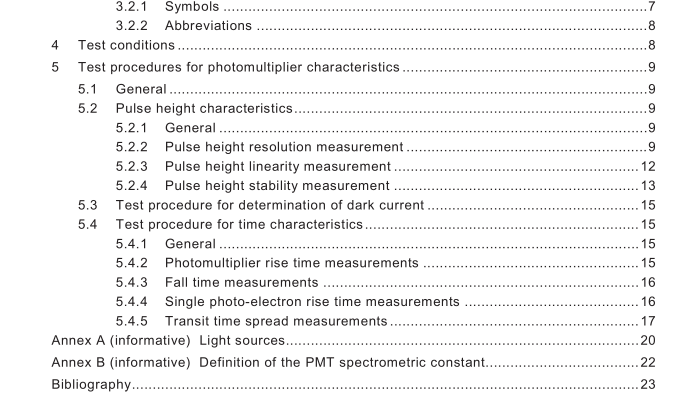IEC 60462:2010 pdf download – Nuclear instrumentation — Photomultiplier tubes for scintillation counting — Test procedures
Charge-storage capacitors may be effectively used across the dynodes or from the dynodes to ground when the ratio of the peak anode current to the average anode current is large and the capacitor can maintain the required dynode potentials for the duration of the pulse. Pulse shaping methods and time constants suitable for optimum performance should be used and should be stated.
5 Test procedures for photomultiplier characteristics
5.1 General In addition to the specifications and test methods of IEC 60306-4, complementary or extended specifications and tests required for photomultipliers used with scintillation and Cherenkov detectors are: a) Pulse height characteristics 1 .
b) Dark current.
c) Pulse timing characteristics.
5.2 Pulse height characteristics
5.2.1 General Pulse height is used in counting and spectrometric applications.
5.2.2 Pulse height resolution measurement
5.2.2.1 General In general there are four distinct PHR measurements to define the photon-and-electron resolution of PMT and scintillator/PMT combinations. These resolutions may be used separately or together.
5.2.2.2 1 37 Cs PHR for a scintillator/PMT combination This PHR is a function of the photocathode quantum efficiency, collection efficiencies of the dynodes and spatial uniformity, as well as the resolution of the scintillator. For standard cases, measurement of 1 37 Cs pulse height resolution requires a 1 37 Cs source, a Nal(Tl) scintillator of 50 mm height and approximately the same diameter as the photocathode, a pulse height analyzer and the photomultiplier to be tested. The photomultiplier tube is optically coupled to the scintillator – for example, with the aid of silicone grease or viscous oil.
The crystal housing should be at photocathode potential. The source is placed at a distance from the scintillator such that less than 1 000 pulses/s are encountered. The PMT should be operated at a voltage such that a linear response is obtained, i.e. the output pulse height is proportional to input light intensity. Improper anode bias, excessive gain (and thus excessive anode current) or improper voltage divider circuits may give rise to a compression of the output pulse distribution, yielding an incorrect (low) value of PHR. The tube/scintillator combination should warm-up for 1 h to obtain optimum PHR.
Phosphorescence of the scintillator and the PMT window may require 1 2 h to decay to a sufficiently low level to permit accurate measurements to be made. Therefore, photomultipliers and scintillators should not be exposed to ambient light for 1 2 h before measurements are made. The test enclosure shall be designed to avoid high electric fields in the region of the photocathode. If the PMT is operated with ground potential at the photocathode (positive high voltage) there is little problem with external electric fields at the photocathode. If negative high voltage is used, electric fields near the photocathode should be low. This may be accomplished by an electrostatic shield at photocathode potential. Otherwise, excessive noise on the output signal, followed by eventual loss of photosensitivity, may develop. As with all PMT measurements, a magnetic shield is required. The 1 37 Cs distribution should be displayed on a pulse height analyzer and so positioned that the upper half of the full-energy peak distribution spans at least eight channels. The total counting rate should not exceed 1 000 s –1 and the integration and differentiation time constants should not exceed 5 μs. At least 50 000 counts shall be contained within the channels comprising the FWHM.
A linear interpolation should be made to determine the value ∆P. Alternatively, other curve- fitting techniques may be used. The method employed should be described. In the case of a computer-controlled pulse height analyzer, a different method can be employed to determine the FWHM by assuming that the upper-part of the full energy peak approximates a Gaussian distribution. While the observed distribution is usually slightly skewed and not truly Gaussian, PHR values determined on the basis of a Gaussian distribution will, in general, agree closely with values obtained from the former method.
